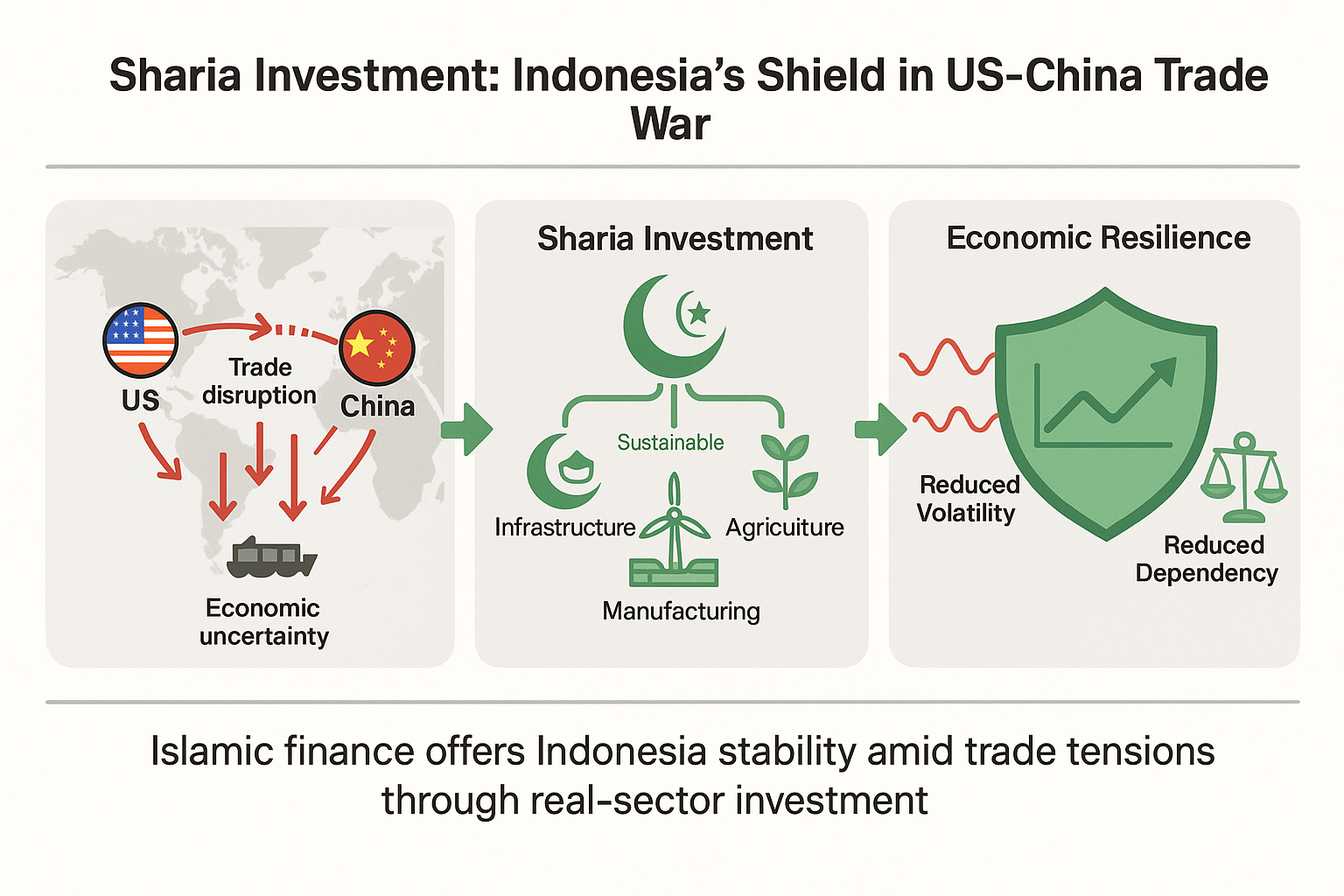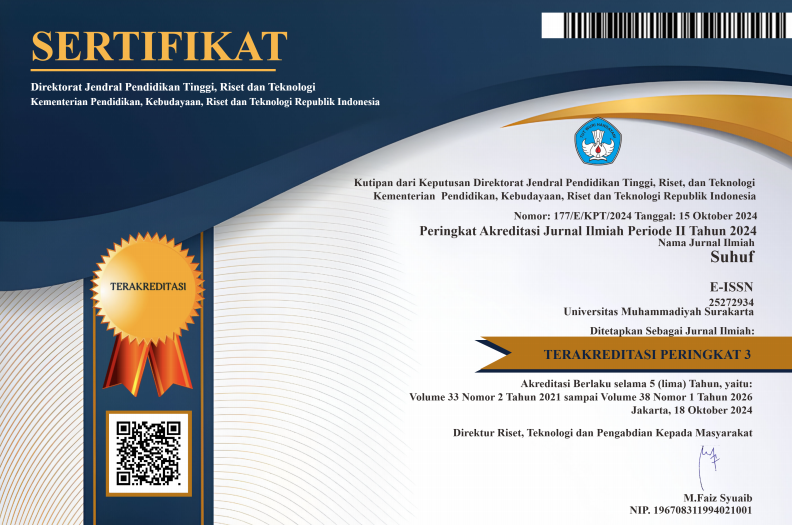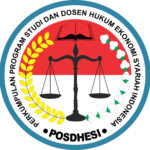Analysis of the Influence of the US-China Trade War on the Indonesian Economy and the Potential of Sharia Investment as a Solution
DOI:
https://doi.org/10.23917/suhuf.v37i1.10041Keywords:
Trade war, US-china, Indonesian economy, Sharia investment, Economic resilienceAbstract
The trade war between the United States and China that began in 2018 significantly impacted the global economy, including Indonesia. The tariff policy implemented by the U.S., especially the one that will continue at its peak in 2025, causes global economic uncertainty, disrupts international supply chains, and lowers Indonesia's trade with the two countries. This study aims to analyze the role of sharia investment in reducing the impact of protectionist policies implemented by the U.S. and China on the Indonesian economy. Using a descriptive qualitative approach with thematic analysis methods and a systematic literature review, this study identifies that Sharia investment can strengthen Indonesia's economic resilience, especially by diversifying funding sources to real sectors such as infrastructure and renewable energy. The findings suggest that sharia investment, with the principles of prudence and sustainability, can be an alternative solution that reduces dependence on volatile global markets and enhances Indonesia's economic stability amid global uncertainty.
Downloads
References
[1] S. Hua and K. Zeng, “The US–China trade war: Economic statecraft, multinational corporations, and public opinion,” Bus. Polit., vol. 24, no. 4, pp. 319–331, 2022, doi: https://doi.org/10.1017/bap.2022.18.
[2] H. Y. Jong, “The art of trade war: Spurring investments in Indonesia amidst the US–China trade war,” Glob. J. Emerg. Mark. Econ., vol. 14, no. 2, pp. 204–221, 2022, doi: https://doi.org/10.1177/09749101211034110.
[3] T. J. McInerney and F. L. Israel, Presidential Documents: The Speeches, Proclamations, and Politics That Have Shaped the Nation from Washington to Clinton. New York: Routledge, 2012. doi: https://doi.org/10.4324/9780203122273.
[4] K. Itakura, “Evaluating the impact of the US–China trade war,” Asian Econ. Policy Rev., vol. 15, no. 1, pp. 77–93, 2020, doi: https://doi.org/10.1111/aepr.12286.
[5] H. Cheng, J. Wang, and M. Hu, “Study on the Spatial Evolution of China’s Pulp and Paper Product Import Trade and Its Influencing Factors,” Forests, vol. 14, no. 4, p. 674, 2023, doi: https://doi.org/10.3390/f14040674.
[6] Z. N. Rosidah, “Limitation of application of sharia principles in sharia economic dispute resolution in religious courts,” J. Moral. Leg. Cult., vol. 1, no. 1, pp. 24–31, 2020, doi: 10.20961/jmail.17i1.41087.
[7] N. S. Imaniyati, R. Januarita, M. F. Mufidi, P. A. A. Putra, and Y. A. Susanto, “Small claim court in Sharia economic dispute settlement: Overview of Sharia economic principles,” Mimb J Sos dan Pembang, vol. 38, no. 1, pp. 114–121, 2022, doi: https://doi.org/10.29313/mimbar.v0i0.8597.
[8] M. R. Saifulloh, “Kebijakan Proteksionisme Indonesia Guna Menstabilkan Iklim Investasi Nasional dan Mengkapitalisasi Kondisi Perang Dagang Amerika Serikat–Tiongkok [Indonesia’s Protectionist Policy to Stabilize the National Investment Climate and Capitalize on the U.S.-Chi,” J. Huk. Lex Gen., vol. 1, no. 1, pp. 51–63, (in Indonesia), 2020, doi: https://doi.org/10.56370/jhlg.v1i1.193.
[9] A. Delle Foglie and G. Pola, “Make the best from comparing conventional and Islamic asset classes: a design of an all-seasons combined portfolio,” J. Risk Financ. Manag., vol. 14, no. 10, p. 484, 2021, doi: https://doi.org/10.3390/jrfm14100484.
[10] J. A. Sandwick and P. Collazzo, “Modern portfolio theory with sharia: a comparative analysis,” J. Asset Manag., vol. 22, no. 1, pp. 30–42, 2021, [Online]. Available: https://link.springer.com/article/10.1057/s41260-020-00187-w
[11] I. Tlemsani, M. A. Mohamed Hashim, and R. Matthews, “Portfolio replication: Islamic vs conventional,” J. Islam. Account. Bus. Res., vol. 14, no. 1, pp. 1–20, 2023, doi: https://doi.org/10.1108/JIABR-09-2021-0261.
[12] B. W. Furidha, “Comprehension of the descriptive qualitative research method: A critical assessment of the literature,” Acitya Wisesa J. Multidiscip. Res., pp. 1–8, 2023, doi: https://www.journal.jfpublisher.com/index.php/jmr/article/view/443.
[13] M. S. Apriantoro, R. D. P. Rosadi, A. C. Ramdhani, and N. Andriyani, “Shaping the Future of Environmental Economics: A Bibliometric Review of Current Trends and Future Directions,” Int. J. Energy Econ. Policy, vol. 14, no. 3, pp. 549–559, 2024, doi: https://doi.org/10.32479/ijeep.15502.
[14] S. Herbert, H. Kingi, F. Stanchi, and L. Vilhuber, “Reproduce to validate: A comprehensive study on the reproducibility of economics research,” Can. J. Econ. Can. d’économique, vol. 57, no. 3, pp. 961–988, 2024, doi: https://doi.org/10.1111/caje.12728.
[15] A. Desai, “Machine Learning for Economics Research: When What and How?,” arXiv, pp. 1–10, 2023, doi: https://doi.org/10.48550/arXiv.2304.00086.
[16] M. J. Page et al., “The PRISMA 2020 statement: an updated guideline for reporting systematic reviews,” bmj, vol. 372, 2021, doi: https://doi.org/10.1136/bmj.n71.
[17] L. A. Kahale et al., “Tailored PRISMA 2020 flow diagrams for living systematic reviews: a methodological survey and a proposal,” F1000Research, vol. 10, p. 192, 2022, doi: https://doi.org/10.12688/f1000research.51723.3.
[18] K. K. R. I. Badan Kebijakan Fiskal, “Laporan Ekonomi dan Keuangan Mingguan: 31 Maret s.d. 6 April 2025,” 2025. [Online]. Available: https://www.kemenkeu.go.id/
[19] K. K. B. Perekonomian, “Laporan Pasar Harian: Dampak Tarif Trump 2.0 terhadap Pasar Indonesia. In Edisi 59/04/2025,” 2025. [Online]. Available: https://ekon.go.id/publikasi/5/kata-data?page=3
[20] R. Purwono, U. Heriqbaldi, M. A. Esquivias, and M. K. Mubin, “The American–China trade war and spillover effects on value-added exports from Indonesia,” Sustainability, vol. 14, no. 5, p. 3093, 2022, doi: https://doi.org/10.3390/su14053093.
[21] N. N. Khofifah, A. Bahrun, W. Oktriawan, and A. A. Muhammad, “The Effect of Religiosity and Disposable Income on Interest in Saving Purwakarta Community in Islamic Banks,” Suhuf Int. J. Islam. Stud., vol. 35, no. 2, pp. 1–10, 2023, doi: https://doi.org/10.23917/suhuf.v35i2.23030.
[22] D. A. Karimah, M. B. Pamuncak, and M. K. Mubin, “The Role of Waqf in Supporting Sustainable Development Goals: Linking theory and its practices,” Suhuf Int. J. Islam. Stud., vol. 35, no. 2, pp. 31–38, 2023, doi: https://doi.org/10.23917/suhuf.v35i2.23018.
[23] E. Smolo, M. H. Ibrahim, and G. Dewandaru, “Impact of bank concentration and financial development on growth volatility: the case of selected OIC countries,” Emerg. Mark. Financ. Trade, vol. 57, no. 7, pp. 2094–2106, 2021, doi: https://doi.org/10.1080/1540496X.2021.1903869.
[24] M. Bank, “Annual Report 2024,” 2024. [Online]. Available: https://www.meezanbank.com
[25] H. Dawood, F. Al Zadjali, M. Al Rawahi, S. Karim, and M. Hazik, “Business trends & challenges in Islamic FinTech: A systematic literature review,” F1000Research, vol. 11, no. March, p. 329, 2022, doi: https://doi.org/10.12688/f1000research.109400.1.
[26] F. Umam and M. Barmawi, “Indigenous Islamic Multiculturalism: Interreligious Relations in Rural East Java, Indonesia,” Ulumuna, vol. 27, no. 2, pp. 649–691, 2023, doi: https://doi.org/10.20414/ujis.v27i2.752.
[27] Bank Negara Malaysia, “Value-based Intermediation Financing and Investment Impact Assessment Framework Guidance Document,” Cantral Bank of Malaysia, no. November. pp. 1–50, 2019. [Online]. Available: https://www.bnm.gov.my/documents/20124/761679/VBIAF_Final+guidance+1.11.2019.pdf
[28] R. A. Puspita, A. Subroto, and L. Y. Arnakim, “Digital Sovereignty in Indonesia-China Trade Relations,” J. Soc. Sci., vol. 4, no. 1, pp. 30–39, 2023, doi: https://doi.org/10.46799/jss.v3i6.454.
[29] M. Hariri, “Characterization of Islamic Investments Funds: Systematic,” Int. J. Econ. Financ., vol. 14, no. 5, pp. 14–25, 2022, doi: https://doi.org/10.5539/ijef.v14n5p14.
[30] M. Alharthi, M. M. Islam, H. Alamoudi, and M. W. Murad, “Determinants that attract and discourage foreign direct investment in GCC countries: Do macroeconomic and environmental factors matter?,” PLoS One, vol. 19, no. 2, p. e0298129, 2024, doi: https://doi.org/10.1371/journal.pone.0298129.

Downloads
Submitted
Accepted
Published
How to Cite
Issue
Section
License
Copyright (c) 2025 Rizki Dwi Putra Rosadi , Wildan Jauhari , S Suratno

This work is licensed under a Creative Commons Attribution 4.0 International License.


















